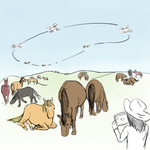
BALASUBRAMANIAM Krishna
Recommendations: 0
Review: 1
Review: 1

Behavioural synchronization in a multilevel society of feral horses
Feral horses synchronize their collective behavior at multiple levels of organization
Recommended by Brenda McCowan based on reviews by Frédéric Amblard, Krishna Balasubramaniam, Krishna Balasubramaniam and 1 anonymous reviewerIn their article “Behavioural synchronization in a multilevel society of feral horses”, Maeda and colleagues (2021) use stochastic multi-agent based modeling to explore the degree to which feral horses synchronize their behavior across multiple levels of organization. The authors compare a drone-derived empirical data set on a feral population of horses with simulated data from multi-agent-based models to determine whether behavioral synchronization of resting and movement states in a multilevel society can be described by one of three models: A) independent model in which horses do not synchronize, B) anonymous model in which horses synchronize with any individual in any unit, C) unit-level social model in which horses synchronize only within units and D) herd-level social model in which horses synchronize across and within units, but internal synchronization is stronger. In a series of 100 simulations for each of seven different models, the authors conclude that evidence for the herd-level model had the strongest support in relation to the empirical data. This finding suggests that connections among individuals in such multi-level societies are rather complex in that local connections are not the only interactions driving social behavior, and specifically synchronization. This approach could be successfully applied to a number of different species that exhibit multi-level organization and possibly fission-fusion dynamics.
This study is especially innovative and interesting for three major reasons. First, the use of drone technology to successfully identify individual animals and generate social networks is highly novel and permits the study of large multi-level social groups of animals that previously have been challenging to study due to limitations in collecting data at an appropriate scale. Second, the comparison of multi-agent-based models with actual empirical data is highly applauded. Most agent-based studies design their parameters from previous empirical studies, (sometimes with questionably simple assumptions) but rarely do they actually compare model outputs to their own empirical data. This is an important next step in the burgeoning field of agent-based modeling. Finally, this study sheds light on the utility of using relatively simple mathematical models to explain highly complex behavior. It also highlights that feral horses can synchronize their behavior beyond clustered local connections which suggests that they possess the cognitive ability to track the behavior of individuals at higher social orders. As the authors state, in a multilevel society, inter-unit distance should be moderate, that is “not too close but not too far” because this strategy simultaneously avoids inter-unit competition while also providing the benefits of social buffering that comes with large group living, such as protection from bachelors or predators.
As the authors dutifully note, there were also some limitations to the study: (1) the relatively sparse empirical dataset that made it difficult to resolve the relative fitness of the two herd-level models (absolute versus proportional social models), (2) the lack of a temporal component that would provide a better understanding on how synchronization flows through the social/spatial network, and (3) the limited variation in the parameters tested which constrained identification of their true function in the model. Such limitations, however, provide fruitful avenues for further development of the model in future studies.
Overall then, this study provides new insights into the processes underlying the behavioral synchronization process and thus nicely contributes to the understanding of collective behaviors in complex animal societies as well as the evolution and functional significance of multi-level animal societies. This study is a fine addition to both the fields of agent-based modeling and the evolution of collective behavior in complex societies. I thus highly endorse its publication.
References
Maeda T, Sueur C, Hirata S, Yamamoto S (2021) Behavioural synchronization in a multilevel society of feral horses. bioRxiv, 2021.02.21.432190, ver. 3 peer-reviewed and recommended by Peer community in Network Science. https://doi.org/10.1101/2021.02.21.432190